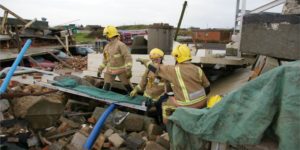 Disasters, whether natural or man-made, strike without warning, causing immense destruction and loss of life. Effective disaster preparedness is crucial to minimizing these impacts and ensuring rapid response and recovery. With the rapid advancement of mobile technology, disaster preparedness has become more accessible and efficient than ever before.
Disasters, whether natural or man-made, strike without warning, causing immense destruction and loss of life. Effective disaster preparedness is crucial to minimizing these impacts and ensuring rapid response and recovery. With the rapid advancement of mobile technology, disaster preparedness has become more accessible and efficient than ever before.
Today, smartphones and mobile applications empower individuals, communities, and emergency responders with real-time alerts, preparedness tools, and response strategies, placing disaster readiness literally in the palm of our hands. This document explores how mobile technology and digital innovations are revolutionizing disaster preparedness and enhancing community resilience worldwide.
The Role of Mobile Technology in Disaster Preparedness
 Mobile devices have transformed the way individuals and organizations prepare for disasters. With features like GPS tracking, instant messaging, cloud storage, and AI-powered analytics, smartphones serve as powerful tools for:
Mobile devices have transformed the way individuals and organizations prepare for disasters. With features like GPS tracking, instant messaging, cloud storage, and AI-powered analytics, smartphones serve as powerful tools for:
- Early Warning Systems: Timely alerts help people evacuate or take precautionary measures before a disaster strikes.
- Emergency Communication: Mobile networks facilitate seamless coordination among first responders, government agencies, and affected populations.
- Disaster Awareness and Education: Mobile apps provide interactive learning tools, checklists, and guidelines to educate users on safety protocols.
- Crowdsourced Information: Social media platforms and mobile apps enable real-time data sharing, helping authorities assess the situation and allocate resources effectively.
- Navigation and Location Services: GPS and mapping applications assist in evacuation planning, route optimization, and rescue operations.
Key Features of Disaster Preparedness Mobile Applications
Several mobile applications have been developed to assist in disaster preparedness. The most effective apps incorporate the following features:
- Real-Time Alerts and Notifications: Push notifications inform users of imminent threats, such as hurricanes, earthquakes, and wildfires.
- Offline Functionality: Some applications offer offline access to emergency contact lists, medical instructions, and survival guides.
- AI-Powered Risk Assessment: Advanced algorithms analyze data patterns to predict potential disaster risks and recommend preventive actions.
- Multilingual Support: Ensuring accessibility for diverse populations.
Examples of Disaster Preparedness Mobile Solutions
Several organizations and governments have launched mobile applications to enhance disaster preparedness. Some notable examples include:
- FEMA App (USA): Provides weather alerts, emergency checklists, and disaster recovery resources.
- MyShake (California, USA): Detects seismic activity and sends earthquake early warnings.
- SAFERTogether (Australia): Encourages community-based disaster preparedness and real-time reporting.
- Google Crisis Response: Integrates search engine data with real-time disaster mapping and assistance resources.
The Impact of Social Media on Disaster Preparedness
Social media platforms like Twitter, Facebook, and WhatsApp play a significant role in disaster communication and preparedness. They facilitate:
- Real-Time Updates: Governments and emergency agencies use social media to broadcast alerts and updates.
- Citizen Reporting: Individuals share real-time information on affected areas, aiding emergency response efforts.
- Fundraising and Relief Coordination: Crowdfunding campaigns help mobilize resources for disaster-stricken communities.
- Public Awareness Campaigns: Hashtags and viral posts promote disaster preparedness education and best practices.
Challenges and Limitations of Mobile-Based Disaster Preparedness
Despite its benefits, mobile technology in disaster preparedness faces several challenges:
- Network Disruptions: Natural disasters often damage telecommunications infrastructure, limiting mobile connectivity.
- Digital Divide: Access to smartphones and the internet is not universal, especially in rural or underprivileged areas.
- Misinformation and Fake News: Social media can spread false information, leading to panic and misinformed responses.
- Battery Dependency: Power outages during disasters can render mobile devices useless without alternative charging solutions.
- Data Privacy and Security: Personal information collected by disaster preparedness apps must be protected against cyber threats.
Future Trends in Mobile Disaster Preparedness
As technology continues to evolve, future developments in mobile disaster preparedness may include:
- AI-Driven Predictive Analytics: Machine learning models will improve disaster forecasting and risk assessment.
- 5G and Enhanced Connectivity: Faster internet speeds will enhance communication and data-sharing capabilities.
- Wearable Disaster Preparedness Devices: Smartwatches and IoT-enabled devices will provide continuous monitoring and real-time alerts.
- Blockchain for Disaster Relief Management: Secure, transparent digital transactions will streamline aid distribution and resource allocation.
Conclusion
Mobile technology has revolutionized disaster preparedness, making vital information and response tools readily available to individuals and communities. By leveraging real-time alerts, AI-driven analytics, and social media connectivity, mobile-based solutions enhance disaster resilience and response efficiency.























































